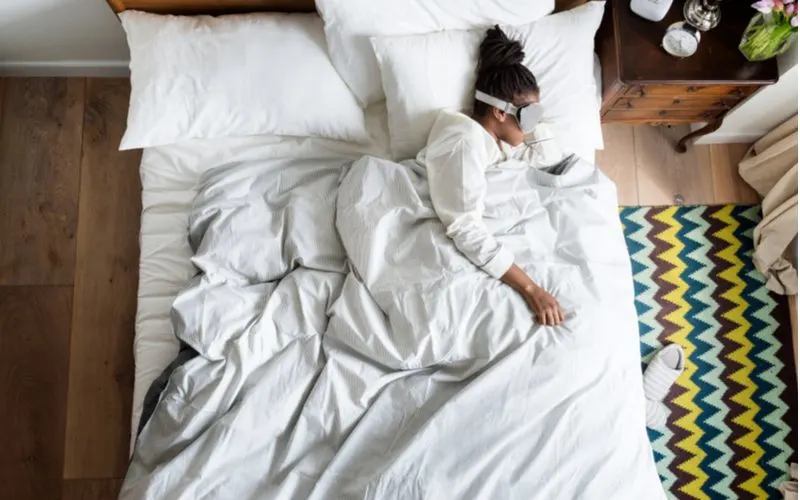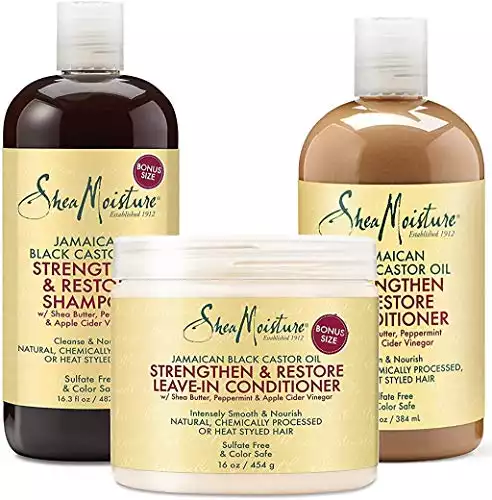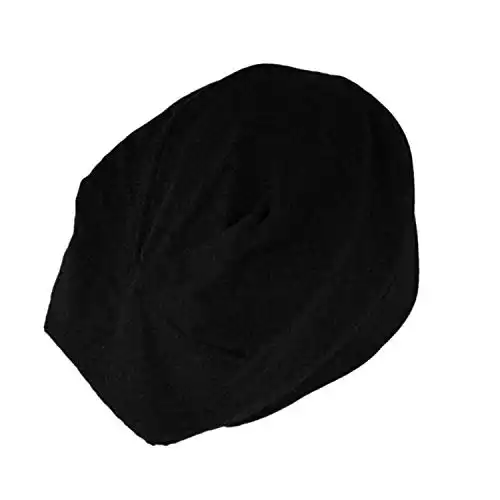Jump to:
Braided hair takes time and money to upkeep and part of the process is learning how to sleep with braids. While braids are quite a contained hairstyle, they require a little TLC to maintain texture and tightness.
Why Knowing How to Sleep With Braids Matters

Krakenimages.com/Shutterstock
Improperly maintaining braids may damage hair, incite frizz, or loosen the braids. Knowing the best nighttime hair maintenance tips ensures your braids last longer and look healthier. Some of the ways nighttime hair care helps braids includes:
- Protecting the delicate hairs at the hairline and nape of your neck
- Keeping edges looking their best
- Preventing dryness in roots and scalp
- Reducing breakage
- Maintaining a newly braided look
For people who wear braids regularly, learning to sleep with braids becomes a habit. Once you know the tricks to keep them in overnight, it will become second nature.
You’ll also notice daytime hair care becomes much easier. If you want to learn how to sleep with braids and the benefits of a good nighttime routine, check out these tips.
Treat Your Hair to Some Pre-Bed Moisture

Viktoriia Hnatiuk/Shutterstock
Before you begin any process of covering your braids, you should invest in some moisture.
Why Moisture is Important for Braids
Wearing braids long-term can be drying. The natural oils from your scalp aren’t moving through your hair the way they would if it were down. Fortunately, you can add some moisture back into your hair with help from a moisturizing treatment or leave-in conditioner.
Options for Nighttime Preventative Care
According to Cosmopolitan Magazine, the best leave-in conditioner for preventative hairstyles, like braids, is Shea Moisture Jamaican Black Castor Oil Strengthen Grow and Restore Lead-in Conditioner. If you have a favorite product, you can use whichever moisturizing treatment you prefer.
Wrap Your Hair
The most common way to protect your braids at night is to wrap them. But it’s not as simple as throwing your hair up in a bun. There are a few things you should know:
What Is a Hair Wrap?
Hair wraps come in many forms, including bonnets and caps or strategically placed scarves. Wrapping your hair ensures that any tossing and turning only rubs your wrap against the pillow and not your braids.
What Type of Hair Wrap Is Best?
The best material to use for any hair wrap is either silk or satin. These slippery fabrics slide easily across sheets and pillows, relieving your hair from the strain of friction.
Avoid cotton and other materials which may grip your pillowcase or braid. For preventative care and overnight care, the best bonnet is the Kitch Satin Sleep Bonnet.
Caring for Your Hair Wrap
Many full-time braid wearers use products to soften and moisturize hair while sleeping. This makes a mess on your hair wrap or bonnet and can create some product buildup.
To not cross-contaminate your old hair product onto your braids every night, keep your scarf or bonnet clean. You may also want to have two or three different wraps in rotation, so you don’t need to put on a load of laundry every other day.
How to Tie Your Braids Back Before Bed
There’s no right or wrong way to tie your braids back before applying your scarf or bonnet. Ultimately, you want it to feel comfortable to sleep on, and not pull at the tiny hairs at the edges of your head.
Tying Back Long Box Braids
There are many informational tutorials on YouTube that explain the best wrap methods for comfort and protection. One presenter, Angie Bee is known for her braid tutorials. She suggests the following steps for preparing box braids for bed:
- Base your hair wrap direction on your part (middle part, side part, etc.)
- Section the hair into two parts at the back of your head
- Twist the two portions as you criss-cross them one over the other
- Bring each section up toward the opposite side of the head from where it originally lay
- Where the braids meet at the top of your head use your scrunchie to tie them together
- Place your bonnet or scarf over the wrapped and tied braids
You can use this same method to wrap long twists, faux locs, or any other long braid.
Tying Back Short Braids
For short braids, which can’t be crossed and wrapped up over the head, you can tie them at the base of your neck, or skip the hair tie method and wrap them with a headscarf. To use just a headscarf, you can use the following steps:
- Fold the square scarf in half to form a triangle
- Place the triangle over your hair so the point falls down the back of your head
- Align the long straight edge of the scarf with your hairline at your forehead
- Bring the ends of the front of the scarf down under your hair and criss-cross them at the nape of your neck
- Pull the ends back up over the hair and scarf and tie them securely over the scarf on top.
This should hold short braids in place for a comfortable and frizz-free rest.
Things to Consider
There are many types of braids in the world, and not every style will wrap the same way. If you are concerned about how well your hair is wrapping at night, speak to a stylist who specializes in braids and braid care.
Practice makes perfect, so don’t get overwhelmed or frustrated if it takes a few tries to get your braids wrapped.
For long braids especially, you will have some braids fall out or pop free. Don’t be discouraged. Remember, you can always secure the fallen braids after you’ve tied your hair in place.
How to Sleep with Braids: FAQs

Rawpixel.com/Shutterstock
For those new to braids, there are plenty of questions about how to sleep with braids. Here are some of the most frequently asked bedtime braid questions:
How do I Wrap my Braids if They Don’t Move?
If your braids are too stiff to wrap around your head, they might be too tight. You can have your braids loosened for a more comfortable sleep.
In the meantime, you can use the scarf method, and leave the majority of length down your back. This protects the scalp and edges of your hair without bending the braids.
Should I Use a Particular Type of Hair Tie?
The tie you use is preferential, but it is recommended that you don’t use anything with exposed elastic. Elastic bands stick to hair fibers and could rip and break hairs. Opt for something smooth like a satin scrunchie or a coil hair tie.
Do I Need a Special Pillowcase for Braids?
Not necessarily, but many braid enthusiasts choose a satin or silk pillowcase to reduce friction. If your scarf or bonnet is satin, a cotton pillowcase is likely just fine.
Why Can’t I Use a Cotton Bonnet?
Cotton is a highly absorbent material. It draws out moisture when you sleep. It will also stick to your braids and could create a fluffy appearance if the cotton rubs on your hair at night.
So, How to Sleep with Braids?
There are many different ways people learn how to sleep with box braids. You should choose the way most comfortable and protective for your braid type and length. The basic steps to protecting braids during sleep are:
- Treat braids for retained moisture
- Wrap and tie braids together so they stay contained during the night
- Apply headscarf or bonnet, or both.
Hopefully, this guide has offered some insight into your nighttime braid routine. If you feel uncomfortable, try a new method of wrapping until you discover one that works for you.


